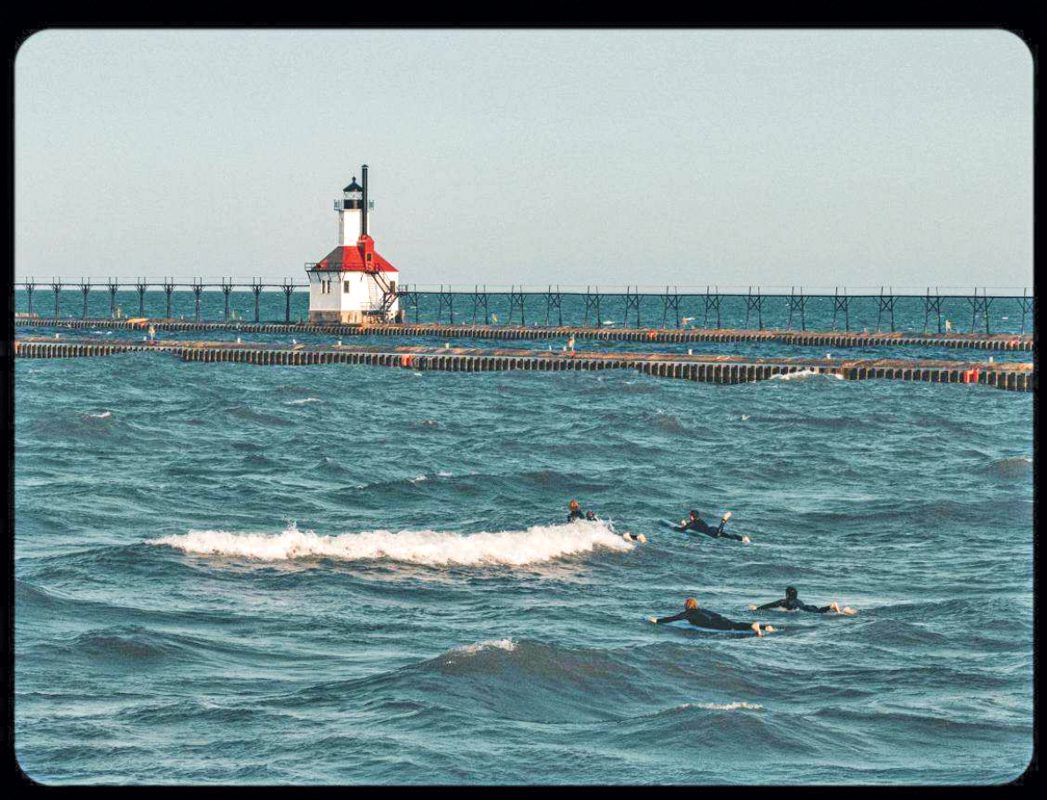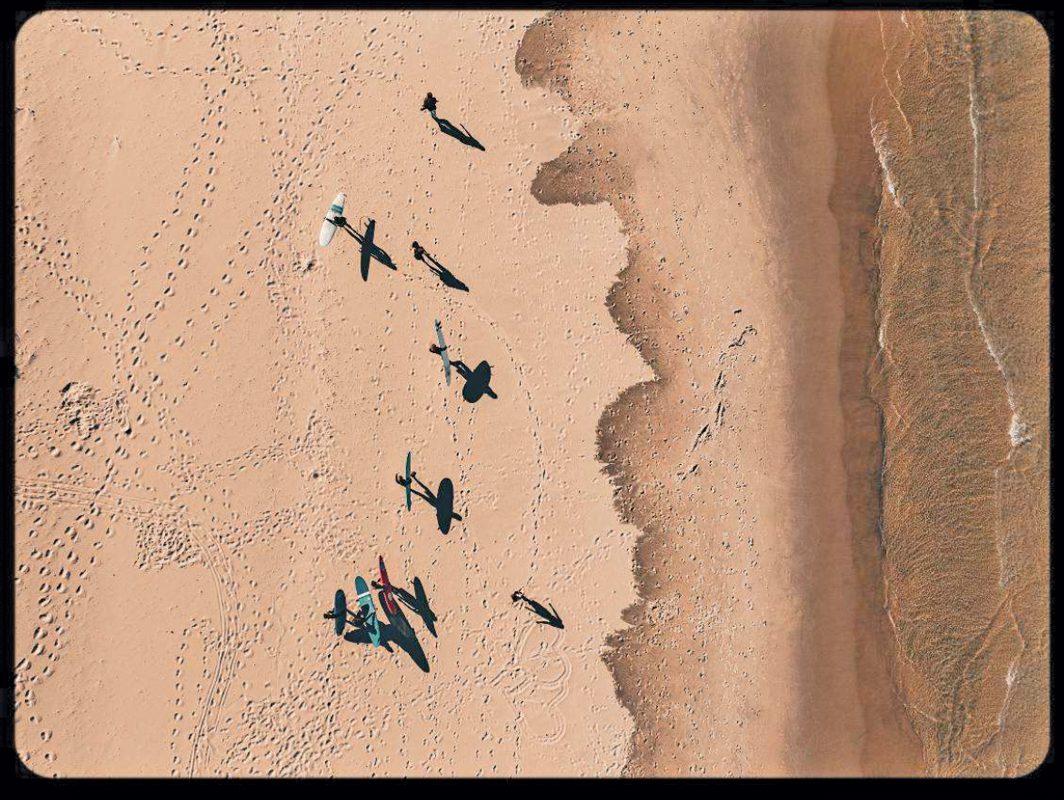
There weren’t enough boards to go around, so we’d swap and share, every ride a communal experience. | Photo by Matilda Mottola
A small cyclone was predicted to hit Lake Michigan on November 21, 2024. Saint Joseph lay still—no wind, just the occasional whisper of movement—but out in the heart of the lake, the waves roared to life. For the MSurf club at the University of Michigan, it was the perfect storm—an unmissable call to adventure.
My phone buzzed with a message from board member Oliver Pourmussa, a senior majoring in economics and computer science: “Last-minute trip. Who’s in?” Within minutes, the crew mobilized. Some hit the road Thursday afternoon, hoping to catch the system at its peak. Others, like me, would leave Friday, chasing the storm’s final echoes at sunrise. I wasn’t a member of the surf club, but they knew I was working on this article—and they asked me to come along.
I dropped my pencil, my notes on the elections I was covering for the Daily, and felt a jolt of adrenaline. It wasn’t just about surfing—I’d done that before, in the warm waves of Mexico. But this? This was Michigan. Surfing here felt absurd, reckless, thrilling. Soon, I’d be able to say, “Yeah, I surfed in Lake Michigan.”
We left around 11 p.m., headlights slicing through the rain as we barreled west. Emily Pytell, an environmental engineering junior, gripped the wheel while Lily Conybeare, a senior in film, television, and media and women’s and gender studies, navigated toward her house, where we’d crash for the night. In the back seat, Mason Fahey, a freshman with an applied exercise science major and salty New York waves under his belt, buzzed with anticipation—his first Great Lakes surf trip. Luc Hascall, a senior in naval architecture and marine engineering and the club’s flat water specialist, planned to meet us later that night. The car pulsed with energy, stories flying, tips exchanged, the cold outside irrelevant against the warmth of shared excitement.
At 1 a.m., we arrived and, without speaking, raced to the water. The lake stretched endlessly, wild and electric. We had made it. For a while, we stood there, letting the wind whip through our jackets, feeling the quiet thrill of being exactly where we were meant to be.
When the alarm shrieked at 7 a.m., darkness still draped the sky. We groggily pulled on layers, laughter breaking the quiet morning. Wetsuits, boards, snacks—we packed up and hit the road again, a caravan of restless souls chasing the waves. There weren’t enough boards to go around, so we’d swap and share, every ride a communal experience.
Best memory? Me, wrestling into a wetsuit meant for Lily’s dad, limbs flailing as three people yanked and shoved, laughing until our stomachs hurt. Did it fit? Against all odds, yes.
By 8:30 a.m., we were in the water. The storm had passed, but its remnants belonged to us. The waves rose, inviting, and we answered. Cold? Of course. But the rush of it all—paddling out, catching the break, feeling the force of the lake beneath us—burned hotter than any chill. Every face gleamed with the same expression: we were in the right place, at the right time.
Related: The Raw Strength and Courage Club
The origins of surfing trace back to twelfth century Polynesia, where the sport was deeply embedded in the culture. It was popularized globally in the 1910s by Duke Kahanamoku, a Native Hawaiian Olympic swimmer. Surfing became a mainland American pastime when servicemen returned from Hawaii after World War II.
Ryan Gerard has been a Great Lakes surfer since the late 1990s. The owner of Third Coast Surf Shop—once a brick-and-mortar store in Saint Joseph, now located exclusively online—tells me that the sport reached Michigan in the 1950s, and has accelerated significantly over the past fifteen years. Gerard attributes this surge to three main factors: advancements in technology, such as improved wetsuits that enable year-round surfing in the Midwest; internet and social media facilitating communication and connection within the surfing community; and increased media exposure. But even though it’s been around for decades, it’s still a niche.
Surfing in Michigan isn’t like surfing on the coasts. You don’t just roll up to the beach with a board and hop in. It’s all about logistics, patience, and a whole lot of improvising. Every session is a gamble—if the wind shifts, if the forecast is wrong, if the gear isn’t right, the whole trip can fall apart before even touching the water.
And then there’s the biggest challenge of all—equipment. Great Lakes waves don’t behave like ocean waves, and neither does the water. “One thing about Great Lakes surfing is that it’s freshwater,” explains Micah Huisman, a senior and MSurf’s forecast specialist. That means it’s “less buoyant. It changes everything.”
You feel it when you paddle, when you pop up, when you wipe out. Freshwater waves are wind-driven, short-lived, unpredictable. And the cold—oh, the cold. Most ocean surfers chase waves in warm places, but Great Lakes surfers? “We surf through the whole year,” Huisman tells me. They suit up in thick winter wetsuits, gloves, boots, and hoods, and paddle out even when there’s ice floating in the water.
Related: The Ascent of Planet Rock
And that’s where things get tricky. The club does everything it can to make surfing accessible—carpooling to the lake, sharing gear, lending out boards. But equipment isn’t cheap, and MSurf’s budget only stretches so far. Wetsuits, boards, gloves—it all adds up, and not everyone can afford it. The club relies on whatever they can find, borrow, or scavenge. If you’re lucky, you fit into a wetsuit someone else outgrew.
Still, somehow, it works. Maybe that’s the magic of MSurf—not just the waves, but the people who make the club possible.
“MSurf is all about the community,” Hascall says. “Obviously surfing is fun, but the coolest part is getting a bunch of surfers together, people who think the same way you do, same exact philosophies, similar definition of fun, we just have an absolute blast.”
One of those surfers is Yejin Kim, a master’s student from Korea studying environment and sustainability. She had never touched a surfboard before joining MSurf but found herself paddling out into the Great Lakes with the rest of the crew. “I was very proud of myself that I tried it without any experience, with others who were already almost professional,” Kim says. “It was a good chance to get out of my comfort zone.”
That’s what makes MSurf special: it’s not just about the most experienced surfers catching the best waves—it’s about bringing people in, no matter where they come from or what their skill level is, and making them feel like they belong.

Photo by William Chavez
MSurf was founded in the 2018–19 school year but became less active during the Covid-19 pandemic. In fall 2023, a small group of enthusiasts stepped in to reinvigorate the club and bring Michigan surfing back into focus.
Initially, there were only four people, but when they showed up at Festifall with a table and a surfboard, they got almost 200 signups in less than two hours. Since then, they created a new group chat and revived a community passionate about surfing, committed to providing a welcoming space for both beginners and experienced surfers to connect, learn, and grow. This school year, MSurf had approximately forty to sixty members.
Although the club members help each other by sharing anything they have, there’s only one board officially belonging to the club, and once everyone graduates in this month, the resources will be very limited. Again.
Pourmussa says that during his freshman year in 2021, the club had six foam surfboards paid for from the club budget. “Then, the guys on the board graduated and the boards disappeared.” He hunted down some of the former leaders who told him they thought the club would die, so they gave the boards to a SEAS professor—who “ended up leaving for Wayne State.” The club has attempted to reach out to the professor, but so far, without success.
But MSurf members refuse to let the lack of equipment or funding stop them from chasing waves. When the Michigan winter proved relentless, they adapted with borrowed wetsuits and sheer determination. And when they dreamed of surfing somewhere warmer (can you blame them?), they found a way.
During spring break last year, seven MSurf members took a surf trip to El Salvador. Led by Lila Hudgins, a junior in art history, they planned every detail meticulously, securing accommodations, surfboards, and transportation through a local contact, Baltazar, who became an invaluable guide and friend. The group, a mix of beginners and experienced surfers, spent a week in El Tunco, a town on the Pacific famous for its world-class waves.
“In a foreign country with a handful of people, naturally, you’re going to spend a lot of time with them. And naturally, you’re not going to leave someone behind, you’re just going to move a little bit as a group. So we went out together. Almost every night. We ate meals together,” Hudgins said. “People matched with other surfers in their level and surfed with them.”

Photo by William Chavez
Whether it’s paddling out into the freezing Great Lakes or navigating surf breaks in El Salvador, the members of MSurf find a way. It isn’t just about surfing; it’s about proving that passion, creativity, and community can overcome any obstacle. And that’s what makes them more than just a club—it makes them a family.
At its core, the surfer mindset is about more than just riding waves; it’s a way of approaching life. Catch the wave, ride the moment, and embrace the present before it fades.
“A big part of surfing is going with the flow. Knowing when you need to try hard and paddle hard versus letting the current take you and enjoy the ride,” Hascall reflects, nodding. “I feel I academically go through things the same way. When you are between exams and you don’t have a lot to do, it’s important to cherish the opportunity and then, when things get real, sometimes you just gotta paddle hard to get through it.”
Related: Sunken Treasures